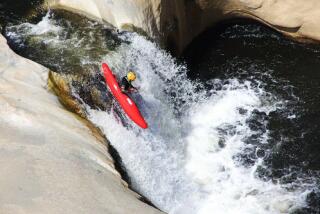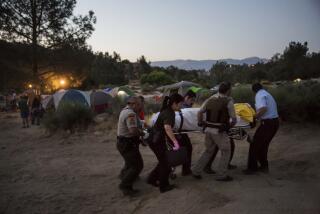Young-Life Preservers : Grieving Parents Help Push Pool-Safety Products, CPR
- Share via
YORBA LINDA — Mary Glass carries a picture of her 20-month-old son, Chris, in her wallet--a golden-haired toddler with blue eyes holding a bunny. It was taken a few weeks before Chris drowned last year in the pool in his back yard.
Four years ago, Bill and Marsha Kerr suffered a similar loss. While they were away on a business trip in Florida, their 2-year-old son, Cody, slipped through the sliding-glass door and fell into the pool.
The two families don’t want others to experience such tragedies, so they joined 50 local officials Tuesday to discuss pool safety and watch a demonstration of equipment designed to save lives.
With summer a month away, pool safety advocates say Orange County is heading into the most critical months of the year for drownings. Through the years, a higher percentage of drownings have occurred during the three months of summer than in all the other seasons combined.
Consumer safety experts believe that the best way to prevent accidents is to put a number of barriers between child and pool. A host of products were on display during the three-hour event sponsored by the Orange County Pool Safety Network, a nonprofit affiliate of Children’s Hospital of Orange County.
Among the items were pool safety covers, door alarms and an infrared detection alarm that sounds when anyone approaches the pool area.
Other devices included removable fencing, a special latch for sliding-glass doors and a hinge system that uses a strong magnet to close gates.
Prices for the safety barriers range from $60 for alarms to $6,000 for pool covers, according to Bill Kerr, a salesman for Life Saver Pool Safety Products based in El Toro. Kerr said he and his wife, Marsha, became more involved in safety techniques after their son died in their pool.
Kerr said if an alarm had been on the door leading to the pool, Cody’s life could have been saved.
“They (barriers) buy the parent time” to get to the child before an accident, Kerr said.
Glass agrees.
“If we had put up another layer of protection, we would still have Chris,” she said wiping her tears. “No one can watch their child 24 hours. It’s that one momentary lapse of eye contact. When you can’t see your child, your ear is on alert. . . . But drowning is silent.”
This is why Dr. Gary Goodman, associate director of pediatrics at Children’s Hospital, stresses that the most important safety tactic is knowing cardiopulmonary resuscitation, an emergency technique that can restore breathing.
“You cannot depend on them (safety barriers),” Goodman said. “They’re not life insurance. The safety net is CPR.”
On Saturday, the Pool Safety Network will hold two-hour sessions at 19 sites across the county with hopes of teaching more than 2,000 adults how to perform CPR on a child. The course costs $5.
Federal studies show that drowning is the leading cause of accidental death for children 4 and under. Last year, there were eight pool deaths in Orange County, all involving children under 4.
Dr. Hildy Meyers, an epidemiologist with the county Health Care Agency, said most of these deaths occurred in back-yard pools or spas. To help get the message across Tuesday, the Orange County Fire Department and paramedics staged an emergency rescue.
Six Orange County firefighters brought equipment to a back-yard pool while Fire Chief Ron Blaul explained the process to the audience. His sons, Dan, 14, and Drew, 13, had key roles in the drama.
As the two youths played by the pool, Drew fell in. After Dan called 911, firefighters rushed to the scene, fished the youth out of the pool and onto a backboard.
While the emergency team performed CPR as the boy feigned unconsciousness, Chief Blaul told the spellbound crowd that it takes four to six minutes from the moment a child stops breathing before brain damage starts.
One firefighter called the hospital to report that the youth was still not breathing. Then Drew was lifted onto the stretcher and rushed off to the emergency room.
Glass and the Kerrs were noticeably absent for that part.
“I talk about (her son) all the time,” she said. “But I just don’t like being near the pool.”
Dangerous Summer Months Of the 143 cases reported in 1991, 57% occurred during the summer, as did 52% of those involving children 4 years and younger.
All ages: June: 29
Ages 0-4: June: 13
Source: Orange County Health Care Agency
Water Tragedies There were 118 near-drownings and 25 drownings, including eight among children younger than 5, reported in Orange County in 1991. More than half of those incidents involved swimming pools.
All Ages Place Number Percent Deaths Swimming pool 82 57% 10 Spa 17 12 2 Bathtub 13 9 4 Ocean 26 18 6 Other* 5 4 3 Total 143 100% 25 * Pond, lake (two cases), decorative pond, Santa Ana River
Ages 0-4 Place Number Percent Deaths Swimming pool 44 66% 6 Spa 14 21 1 Bathtub 7 10 0 Ocean 0 0 0 Other* 2 3 1 Total 67 100% 8 *Decorative pond, lake
More to Read
Sign up for Essential California
The most important California stories and recommendations in your inbox every morning.
You may occasionally receive promotional content from the Los Angeles Times.




![Vista, California-Apri 2, 2025-Hours after undergoing dental surgery a 9-year-old girl was found unresponsive in her home, officials are investigating what caused her death. On March 18, Silvanna Moreno was placed under anesthesia for a dental surgery at Dreamtime Dentistry, a dental facility that "strive[s] to be the premier office for sedation dentistry in Vitsa, CA. (Google Maps)](https://ca-times.brightspotcdn.com/dims4/default/07a58b2/2147483647/strip/true/crop/2016x1344+29+0/resize/840x560!/quality/75/?url=https%3A%2F%2Fcalifornia-times-brightspot.s3.amazonaws.com%2F78%2Ffd%2F9bbf9b62489fa209f9c67df2e472%2Fla-me-dreamtime-dentist-01.jpg)








